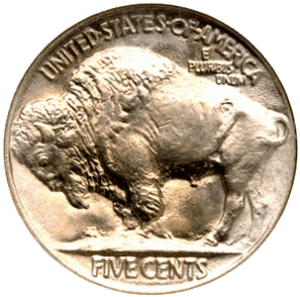
Buffalo nickels, also sometimes referred to as Indian Head Nickels, were released on President Howard Taft’s last day of office, on March 4, 1913. They replaced the liberty nickels. These collectible coins would be produced until 1938. If you didn’t know, twenty five years is the minimum period of time a coin must be in production. To change a coin sooner than that would literally require an act of Congress.
History of Buffalo Nickels
James Earle Fraser was hired by the Taft administration after reviewing his designs that portrayed a Native American and a buffalo, also known as an American bison. The designs were approved in 1912, but production was delayed due to concerns from the Hobbs Manufacturing Company.
Eventually, in February of 1913, the Treasury made the decision to move forward with producing the Buffalo Nickels. It was officially released on March 4, 1913. With that said some coins were actually given out during a ceremony for the National American Indian Memorial on the 22nd of February, 1913.
They would continue to be produced until 1938.
Buffalo Nickel Coin Details
Buffalo Nickels are worth five cents, has a mass of 5.000 g, a diameter of 21.21 mm, and a plain edge. It is made up of 75% copper and 25% nickel. Coins were produced in Philadelphia (no mint mark) Delaware (“D” mint mark), and San Francisco (“S” mint mark).
Both the front and back were designed by James Earl Fraser. The front of the coin (obverse) presented a Native American’s right side profile, while the reverse side had a left side profile of an American bison (buffalo).
When these coins were first released, the date was on the mound that the buffalo stood on. Because it was raised, it wore away easily. A Type 2 coin was released later in the year that would place the date underneath the mound. This protected the date from wear.
Buffalo Nickel Values
A 1918/7 D 5C MS65 PCGS (PCGS is a professional coin grading company) graded coin was sold at Heritage Auctions on January 7, 2010 for $264,500.00. Meanwhile, some worn out common buffalo coins value out at it’s issued value, which is five cents. That’s a pretty large range, if you ask me.
You may also want to learn about the coin grading scale if you’re not familiar with what MS65 means.
For detailed information on each coin, choose one below. If a year isn’t listed, that means that no buffalos were minted that year:
Key Dates
As we have learned, these coins greatly vary in price. So what are the key dates?
- The 1913-S Buffalo Type 2 Nickel was the second coin in the first year of production. It says, “Five Cents” underneath the buffalo, rather than on the mound. This change was made to protect the “Five Cents” from being worn away over time.
- It is speculated that their may have been private sales of the 1918/7 D coin for as much as half a million dollars. If you can find one in any condition, it’s a spectacular find.
- The 1937-D 3 Legged Buffalo is missing one of its legs. This coin could be worth as much as $125,000, depending on the condition. However, it is rare to find these in high grade conditions.
Adding This Coin to a Collection
The first coin I ever bought was a 1938-D PCGS graded MS65 Buffalo. In fact, at the time of writing I still have it to this day. I know it’s not a hugely unique coin, but I was drawn to this coin because it was an inexpensive way to get a nicely graded coin that I was excited about.
These coins are a great addition to any collection. There are some great finds out there, so look around and see what you can find.
How about you? Do you remember when you first invested in Buffalo Nickels?
Happy Collecting!

